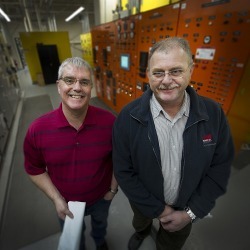Ready to power up!

When St. John’s experiences a power outage, Memorial University is a shining light in an otherwise dark city.
Throughout the year, Memorial’s St. John’s campus produces its own heat at the university’s high temperature hot water (HTHW) plant for most buildings on campus as well as the Health Sciences Centre. The university purchases power from the local utility (Newfoundland Power) which is supplied to the main university substation. The Department of Facilities Management is responsible for the distribution of high voltage electrical power from this substation to all buildings and infrastructure on the St. John’s campus and the Health Sciences Centre. The campus uses about 18 megawatts on an average day; however, this requirement can go higher during the winter months. With thousands of students and employees on campus daily, it is imperative that the university is ready to act in the event of a loss of this power.
Memorial’s readiness to act is two-fold. The university has the ability to respond to both the needs of the main campus and to the needs of the Health Sciences Centre.
To address the campus’ needs, Memorial has emergency generators that have a combined capacity of producing 3,500 kilowatts of emergency power for the residences, main dining hall and key safety areas such as lighting on stairs and the operation of pumps for heating.
According to Shane Lewis, electrical shop supervisor with Facilities Management, the safest place to be during a power outage is on campus.
“During a power outage our team is on site to make sure everything is okay. We are committed to keeping people safe and we are especially focused on the people who live on campus. We do everything we can to make sure they have what they need,” said Mr. Lewis.
In describing the team’s commitment, Mr. Lewis detailed their activities during the extended power outage that occurred in January 2014.
“During #DarkNL, our whole team was in. We ran all of our generators, conserved power wherever we could, and we controlled our electrical load. While doing this, students on campus were fed and kept comfortable in a safe environment. This was a priority for us,” said Mr. Lewis.
The extended #DarkNL experience provided learning opportunities and identified areas where improvements could be made. For example, some buildings encountered damage due to pipes that froze and burst and the team discovered some equipment that should be considered for emergency power. Since then, the university has gained a better understanding of the additional items that require emergency power during an extended outage and what doesn’t. An incredibly valuable lesson learned from the outage was how successful the university can be in significantly reducing its electrical load due to reduced amounts of power being available from NL Power. As a result, Memorial is better prepared to respond should another extended outage occur.
In addition to its campus readiness, Memorial has the capacity to produce 3,200 kilowatts of emergency power for the Health Sciences Centre, for this the university maintains four generators each with the capacity of producing 800 kilowatts.
During an outage at the hospital, the back-up generators start up and supply power to both the hospital and to the required circulating equipment to produce the steam generation at the HTHW plant. Memorial’s system takes about eight seconds to get the hospital on back-up power. The system recognizes when power loss is first occurring (called a brown out) and starts to come on line so that when power is actually lost it is just moments before power is transferred. Sometimes this happens so fast it is just a blink in time. Power is therefore maintained for operating rooms, prenatal intensive care and other life-saving systems.
In facilities management, the electrical shop and utilities teams work hand-in-hand to ensure operations on campus and in the hospital can be restored as quickly as possible when a power loss occurs. As part of their preparations, the teams conduct regular training and tests on the system.
“The HTHW plant has four boilers and, at any given time during the winter season, we normally have two of the four boilers running. Twice each day, we start up the other two and run them to ensure they are working properly and efficiently. We also bring in an external contractor annually to calibrate all of our instruments and to conduct combustion efficiency testing,” said Jeff Boland, manager of central utilities.
In addition to the testing of the HTHW plant capabilities, testing is conducted every Tuesday by the electrical shop team on the back-up power system. This ensures readiness and provides employees with opportunities to maintain their familiarity with the back-up process.
To operate the HTHW plant, including all boilers throughout the campus, and to provide the university and Health Sciences Centre with all electrical requirements, Memorial employs 26 power engineers and 29 electrical personnel. The university also offers an apprenticeship program whereby new grads of the College of the North Atlantic (CONA) and Academy Canada programs are provided apprenticeship opportunities.
The university’s HTHW plant and back-up power capabilities have grown considerably over the years. Additional expansions of these capabilities will occur in coming years to accommodate the continued growth of the St. John’s campus.